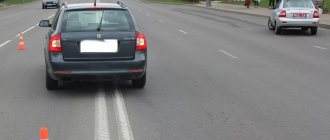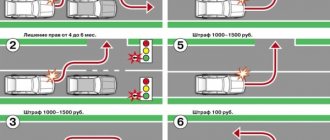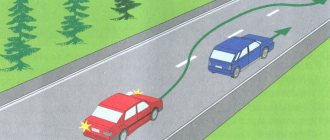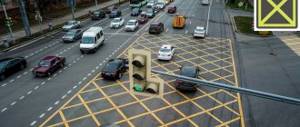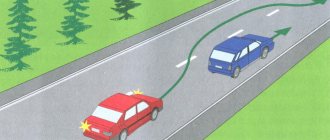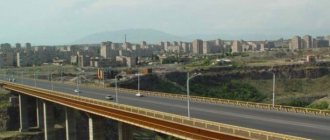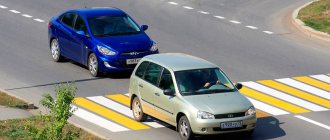Types of solid lines according to traffic rules
According to traffic rules and GOST 51256-2011, solid lines are divided into several types:
- Single (or line 1.1) - like a broken line, divides the roadway into two differently directed flows, but its main function is to mark especially dangerous sections of the highway, where any departure into the oncoming lane can be fatal;
- Single (1.2) – slightly wider than lane 1.1 and marks the boundaries of the roadway on both sides of the highway;
- Double (1.3) – also divides the route into equal halves, but is applied exclusively to roads where cars move in four streams or more;
- The yellow line (1.4) is the least common and indicates places on the edges of the roadway where stopping cars is prohibited.
There are also yellow and orange lines. They are used to mark out new detour routes during road works. They are temporary and will also have to be followed.
All of the listed types of continuous markings are strictly prohibited from crossing unless you have special reasons for this, which we will talk about in the appropriate paragraph. There is a fine for flouting the rules.
Table of penalties for crossing a solid line and a double solid line
Crossing continuous markings is not always punished equally. When drawing up a report, the traffic police inspector must study the circumstances of the incident.
| Type of violation | Article of the Code of Administrative Offenses of the Russian Federation, which covers the offense | Punishment, (rub.) |
| Overtaking by crossing a solid line | Part 3 art. 12.15 | 5000 or deprivation of rights for 4-6 months |
| Avoiding obstacles | Part 3 art. 12.15 | 1000-1500 |
| Turn left or make a U-turn | Part 2 art. 12.16 | 1000-1500 |
| Moving in the oncoming lane before turning left | Art. 12.15 | 5000 |
| Hitting a solid line with one wheel | Part 1 art. 12.16 | 500 |
As can be seen from the table above, penalties for crossing a continuous line vary depending on the reasons that provoked the violation. In order to understand what penalty awaits the driver when stopped by a traffic police officer, it is necessary to study in more detail the possible circumstances of the incident.
Overtaking cars moving in the same direction, accompanied by crossing a continuous line, is qualified by Part 3 of Art. 12.15 Code of Administrative Offenses of the Russian Federation. Punishment for such a violation may include deprivation of the driver’s right to drive the vehicle.
If the offense was committed for the first time and did not result in an emergency, then the driver has a fairly high chance of receiving a penalty in the form of a monetary penalty.
If a continuous crossing is recorded on a photo/video camera, then Art. 12.15 part 5, the punishment for which is limited to a fine. Deprivation of driving license is possible only when stopped by a traffic police inspector.
In accordance with the traffic rules, if there is an obstacle to traffic on a section of the road with continuous markings and there are no temporary signs allowing detour in the oncoming lane, the driver is obliged to go around it on the right side (not on the side of the road). If this is not possible, then the motorist must eliminate the reason for the stop.
This violation is also regulated by Part 3 of Art. 12.15 of the Code of Administrative Offenses of the Russian Federation and implies a monetary penalty of 1000-1500 rubles.
In practice, drivers overcome stationary objects on the left, thereby violating traffic rules. If it is impossible to pass on the right, most traffic police inspectors limit themselves to only a warning and release the driver without imposing penalties. In order to avoid punishment, you must let all oncoming traffic pass and only then make a detour.
A traffic jam or a car standing on the roadway, according to traffic regulations, is not considered an obstacle. Driving in oncoming traffic in such circumstances is punishable by a 5 thousand fine or deprivation of a driver's license.
If a motorist, with the intention of turning left, crosses two solid lanes or one and, before making the maneuver, drives even 1 meter in the oncoming lane, then he will be punished in accordance with Part 3 of Art. 12.15 Code of Administrative Offenses of the Russian Federation. As has already been said, penalties for such an offense can range up to deprivation of the driver’s license.
Hitting a marking with one wheel most often occurs when a car is entering a turn or when driving a large vehicle. In this situation, an offense is also committed, but regulated by Art. 12.16.1, and the driver will receive a fine of 500 rubles.
In such a situation, it is inappropriate to talk about Art. 12.15, since the marking lanes are not areas for traffic in the opposite direction.
A U-turn through solid markings (the same as a turn) is punishable in accordance with Art. 12.16 p. 2. According to the rules, the driver must get to the place where the line is interrupted and make a maneuver.
Most often, the violation is committed when leaving the yard onto a public road. The driver immediately turns left, although according to the rules he must turn right, drive to a place with intermittent markings and only then turn around to move in the opposite direction.
Penalty for crossing a double solid line marking and other types of punishment 2021
Methods for recording violations and evidence
The main ways to detect violations on the road are:
- Surveillance, video recording and measurements of traffic parameters using special means, carried out by employees of the State Traffic Inspectorate.
- Automatic fixation systems and complexes. The scope of their application is limited to a few types of offenses, but will expand.
- Photographs and videos of eyewitnesses. Recordings made on a surveillance camera or video recorder.
Do cameras detect driving beyond the double solid line?
The FVF funds register this type of violation, but it is possible to lose a driver’s license only if a report is drawn up by the traffic police inspector who stopped the car.
What is the threat and to what extent?
When leaving the yard
When leaving the yard, a left turn crossing a double solid road will result in a fine of 1–1.5 thousand rubles. This is part two of article 12.16.
Major violations
A violation is considered repeated if it is committed before the expiration of 1 year from the date of drawing up the first protocol. Overtaking and driving on the opposite side in such a situation is punishable by deprivation of your driving license for 1 year.
Other violations related to crossing a continuous lane are punished in the same way as the first time.
Violations of traffic lanes are also ranked, and the amount of punishment for each is individual according to its article of the Code of Administrative Offenses of the Russian Federation. Let's look at some of the most common mistakes that can lead to a fine or deprivation of rights.
For crossing a single continuous line and entering oncoming traffic, you will have to pay from 1,000 to 5,000 rubles, or the driver’s license will be revoked for up to six months - it all depends on the specific case and the severity of the incident. All cases of violation of markings are regulated by the provisions of Articles 12.15 and 12.16 of the Code of Administrative Offenses of the Russian Federation. We will look at them below.
The amount of the sanction can be halved if you pay the fine within the first twenty days from the date the decision on the administrative offense is issued (not to be confused with the entry into force).
We invite you to read: Do I need to pay tax when buying an apartment? What do you need to know when buying an apartment?
There are no specific points in the rules entitled “crossing a single line” or “crossing a double solid line”. The articles do not divide the road into dangerous and especially dangerous sections using types of solid lines, so there are no differences in penalties either. The double line simply indicates that the track is particularly wide and the cars on it move in several unidirectional flows from different directions.
The punishment for attempting to overtake a car across a solid line is noted in Part 4 of Article 12.15 of the Code of Administrative Offenses of the Russian Federation.
- For crossing continuous markings when overtaking, a fine of 5,000 rubles is imposed. or deprivation of rights for four or six months.
- If the offense is repeated within a year, the motorist will lose his driver’s license for one year.
- If the violation was recorded by a camera, then in any case the penalty will be 5,000 rubles. (Article 12.15 part 5).
If the driver starts overtaking and enters the oncoming lane, bypassing the intermittent line, and returns to his flow through the solid line, then a fine is inevitable. So consider your options.
For turning or turning a car across a solid line, you will be punished under Article 12.16 part 2 of the Administrative Code of the Russian Federation. You will have to pay an amount from 1,000 to 1,500 rubles. at the discretion of the traffic inspector.
ATTENTION! The same provision of the article regulates leaving the yard and turning left across a continuous line. The punishment is the same - 1-1.5 thousand rubles.
Avoiding obstacles
If you ignore the solid lane and drive into the oncoming lane in order to go around the obstacle, you will have to pay an amount from 1,000 to 1,500 rubles. (Article 12.15 part 3 of the Code of Administrative Offenses of the Russian Federation).
This is the most controversial point of the traffic rules, which is very often misinterpreted. It is not always possible to accurately determine the severity of a traffic jam, especially when it comes to video recording equipment. It will definitely impose a sanction, even if you are trying to legally avoid an open hatch or an accident. How to prove you are right, read below.
Expert opinion
Evgeniy Romanov
Lawyer, specializes in protecting rights in areas related to traffic rules, insurance and disputes with the traffic police.
A traffic jam or a car on the roadway is not an obstacle, and for trying to drive through oncoming traffic they will be punished under Article 12.15 part 4 of the Code of Administrative Offenses of the Russian Federation: 5,000 rubles. or deprived of documents for a period of 4 to 6 months.
Hitting with one wheel
If you did not cross a solid marking, but only ran over it with one or two wheels, then this is already considered a violation of the location of the vehicle on the roadway and is regulated by Article 12.15, Part 1 of the Code of Administrative Offenses of the Russian Federation - 1,500 rubles. fine
This is a very controversial point and it is extremely rare, even in court, to prove that there was a collision with the line, and not crossing it. In most cases, no one will look into it and they will be fined a larger amount.
Let's summarize all our data in a table for clarity.
| Violation of continuous markings | Fine |
| Overtaking | – 5,000 rub. or deprivation of rights for 4-6 months (Article 12.15 part 4 of the Administrative Code); – for a repeated violation, your license will be taken away for one year (Article 12.15 Part 5 of the Administrative Code); |
| U-turn or rotation | 1,000 or 1,500 rub. (Article 12.16 part 2 of the Code of Administrative Offenses of the Russian Federation); |
| Avoiding obstacles | 1,000 or 1,500 rub. (Article 12.15 part 3 of the Code of Administrative Offenses of the Russian Federation); |
| Hitting with one wheel | 1,500 rub. (Article 12.15 part 1 of the Administrative Code); |
Fine
Until 2008, crossing the prohibited line was considered to be driving into oncoming traffic and was severely punished under any circumstances. Today the situation has turned its face towards drivers - the Code of Administrative Offenses spells out in which cases the driver faces deprivation , and in which cases the driver will get off with only a fine .
Here you will find information about other fines for traffic violations.
Do you lose your license for crossing a double line?
Let's consider cases when the offender faces the most severe punishment .
- Overtaking in the oncoming lane ( Administrative Code, part four, article 12.15 ). Withdrawal of rights for a period of 4-6 months .
In this case, it does not matter who they tried to get ahead of. Even if it was a weaving rattle. The guilt is obvious, even if the second car did not give way, having pulled over to the side of the road, as prescribed by traffic regulations; - Turn left ( Administrative Code, part four, article 12.15 ). A U-turn before reaching the intermittent markings that allow turning will backfire on an impatient driver.
If the camera recorded
If an illegal maneuver is recorded, the owner of the car receives a decision to pay a fine .
ATTENTION The recording is not a reason for deprivation of a driver's license in absentia. For such a preventive measure, the traffic police officer must draw up a protocol at the scene of the violation together with the driver of the car. That is, guilt is established based on the fact of traffic violation.
Intersection of double solid
Unforeseen situations may arise on the road. For example, in the middle of the lane there is a stalled car and does not allow others to pass. According to traffic rules, you can go around it on the right. This is not always possible in reality.
In this case, you are allowed to cross the prohibited marking and drive around it on the left side. But provided that there is no other vehicle coming towards you. Traffic police officers do not have the right to punish for such a maneuver.
But if it was still possible to overcome the obstacle from the safe side (right), then a fine from 1,000 rubles to 1,500 rubles ( Administrative Code, third part, article 12.15 ).
Turn left through a double lane
In this case, a solid line and oncoming traffic flow intersect at once. Code of Administrative Offenses ( third part of Article 12.15 ) – monetary penalty from 1,000 rubles to 1,500 rubles .
Reversal through double solid
For some reason, many are sure that if they do this in a manner they will inevitably be deprived of their ID. And sometimes traffic police officers take advantage of this ignorance.
The new traffic rules clearly indicate that driving into an oncoming lane connected to a U-turn is punishable by a fine of 1,000 to 1,500 rubles ( Administrative Code, third part, article 12.15 ).
What does the punishment depend on?
The most common controversial situations, as well as ways to avoid punishment in them, are:
- The markings are erased, blurred and difficult to see. This situation is very common on Russian roads due to the fact that it is applied quite rarely. This circumstance, especially confirmed by photo and video materials, can become direct evidence of innocence.
- If there was a collision with one wheel on the marking line. In this case, there was no fact of crossing a continuous strip, and therefore a completely different preventive measure is applied - 1,500 rubles for violating the position of the car on the roadway (even a minor collision of 1 cm is considered a violation).
- Crossing a solid lane when leaving a parking lot. The fine in this case will be 500 rubles. Leaving the yard also falls under this case.
- There was no way to get around the obstacle and, as a result, I had to cross a continuous strip. Anything can become an obstacle (a car abandoned by someone, a fallen tree, a stone in the middle of the road). It was not possible to avoid punishment if you made a detour on the right.
- Crossing a solid marking line in order to avoid an accident is the most controversial situation. In order to prove your case and “extreme necessity” in this case, you can refer to Code of Administrative Offenses 2.7.
Article 2.7 of the Code of Administrative Offenses of the Russian Federation. Urgent necessity
It is not an administrative offense for a person to cause harm to legally protected interests in a state of extreme necessity, that is, to eliminate a danger that directly threatens the personality and rights of a given person or other persons, as well as the legally protected interests of society or the state, if this danger could not be eliminated by other means. and if the harm caused is less significant than the harm prevented.
As we see, in many controversial issues it is possible, if not to completely avoid punishment, then to minimize the cost of fines. And if you pay within 20 days after receiving the decision, the driver will be able to count on discounts when paying the fine.
There are several points that can reduce or increase the penalty.
- According to the law, responsibility is dictated by a specific clause of the Code of Administrative Offenses of the Russian Federation - some offenses are recognized as more serious and imply a greater chance of creating an emergency situation, and accordingly the sanction for crossing the markings will be greater.
- The traffic police inspector can independently choose the penalty. If he considers that a lighter punishment option is fair in this case, he will issue a fine in monetary terms, but if, in his opinion, your action could have caused an accident, he will take away your rights for a period that is also given to him for consideration.
It may happen that the driver gets off with a warning altogether - the employee decided that there was no serious violation of the rules. Situations on the roads vary greatly, and it is difficult to predict his reaction.
- When it comes to cameras, they issue maximum fines, and this is not always fair. Read about them below.
We suggest you read: How long does it take to schedule a court date after filing an application?
The most important rule for protecting your rights from unfair penalties: buy a video recorder, and seek justice with evidence of your words in front of the inspector himself or in court. The recording file can and should even be used to confirm your words. The most common case is if there is a serious obstacle on the road that cannot be avoided without entering the oncoming lane, and this necessarily involves crossing a solid line and violating the general rules.
It is easier for a traffic police officer to prove his innocence, since he is obliged to understand and issue an order on the spot - accordingly, it is easier to explain the traffic situation. Try to emphasize that it is not your fault for the incident, but that you were a victim of the actions or inactions of other drivers. It may happen that the amount of the fine can be reduced down to a simple warning.
If you do not agree with the punishment, then write a complaint to the regional traffic police department that issued the resolution, or go to court.
Reasons for unlawful collection may include:
- Extreme necessity - you tried to avoid an accident through no fault of your own;
- The offense was recorded using a smartphone or other unsealed device;
- The lane is erased and it is impossible to determine how to act - this is a problem for road services, not drivers;
- The camera read the license plates incorrectly and you were fined by mistake;
Prepare photos and videos as evidence, or witness statements that will help you defend your innocence. Here are some actions that can help you defend yourself:
- As soon as the inspector approaches you, ask him to introduce himself and write down his details;
- Explain the need for the maneuver;
- Make sure that all the circumstances of the case are recorded in the protocol;
- There is a column in the protocol where you can state your version - use this and explain everything there;
- On the spot, take a photo of the road markings; if they are poorly marked and completely unreadable, photograph the place where you were stopped for a violation, and all the actions of the traffic police officer. Try to get him to make all the accusations on the record. If there is an extortionist or an unscrupulous inspector in front of you, the camera will scare him away.
In any case, it will not be a bad idea to make a couple of materials in case of litigation. If you do not have evidence on hand, then the same camera recording violations can help you if it hangs somewhere nearby. Request records when you file a complaint with the traffic police.
To appeal the protocol you have ten days from the date of its preparation. Use this time to file a complaint with the authorities or the court.
In what cases can you challenge a fine?
The set of provisions that regulates fines and other types of punishment for administrative offenses is regulated by the Code of Administrative Offenses of the Russian Federation.
According to part one of Article 12.16 of the Administrative Code, driving through a solid line in the same direction without complying with the requirements of road markings 1.1 entails a warning or a fine of 500 rubles.
For example. On a 4-lane road, the driver of a passenger car (A) decided to overtake a cargo vehicle (B) in front of the bridge. To the left of it is a horizontal marking 1.1, indicating the prohibition of crossing. Driver A crossed the solid marking line while passing! direction, but he committed this action in violation of traffic rules. Therefore, he will face punishment in accordance with Part 1 of Art. 12.16 Code of Administrative Offenses of the Russian Federation.
When turning through a solid lane 1.1 in order to change lanes in another direction from 1000 to 1500 rubles, Art. 12.16, part 2.
The law provides for cases when crossing a continuous strip is allowed. One of them was described above - avoiding an obstacle. Other circumstances that allow driving into oncoming traffic:
- If overtaking began on a section of road with permissive (intermittent) markings. According to clause 11.4 of the traffic rules, he must complete the maneuver in any case, therefore, in this situation, crossing a continuous road does not entail punishment. In practice this is not always the case. In most cases, the driver is required to provide evidence that overtaking was started in the required place (dash camera recording);
- If temporary road signs are installed allowing oncoming traffic to enter the area. In accordance with traffic rules, they have priority;
- Crossing continuous markings to prevent an emergency. In case of proceedings with traffic police officers, you can refer to Art. 2.7 of the Code of Administrative Offenses of the Russian Federation, according to which such a technique is qualified as an extreme necessity.
Even when crossing a continuous marking legally, the driver must be prepared for the fact that when stopped by a traffic police officer, he will have to defend his case.
The driver has the right to challenge the fine. This happens in court. The chances of a successful outcome are quite high if:
- Fuzzy solid line. If the markings are not clearly visible (erased or incorrectly applied over the old one), then the driver must indicate this in the appeal request. To confirm your words, it is recommended to present testimony of eyewitnesses to the offense, as well as photo or video materials;
- Recording the violation on camera. The fact is that FVF devices (photo/video recording) are not able to distinguish the circumstances of the incident. In this case, you will also have to provide evidence of your innocence.
If the motorist does not agree with the imposed punishment, he must submit a corresponding application to the judicial authority within 10 days. After the specified time has passed, it will not be possible to appeal the decision.
Crossing solid markings is a dangerous offense because moving through the area for oncoming traffic contributes to a potentially dangerous emergency situation. To reduce such incidents, the government has established fairly severe penalties for this violation.
Crossing a double solid line was recorded by the camera punishment
How to avoid responsibility? In any difficult situation when you disagree with the traffic police inspector, follow the simple rules:
- do not sign the resolution and do not pick up the payment receipt;
- ask for a protocol to be drawn up and carefully monitor its completion;
- write down the patrolman's badge number, rank, car number, full name;
- It is always useful to record the circumstances with a DVR.
Examples of controversial situations:
- A driver who starts overtaking on a broken line and ends it on a solid line can refer to paragraph 11.4 of the rules of movement on the road, which requires completing overtaking.
But if the driver, before reaching the break in the solid line at the intersection, begins to turn and crosses the latter, while driving at least a meter and a half in the oncoming lane, then this violation can be legally punishable by deprivation of rights, as well as an administrative fine of 5,000 rubles . Features of recording violations using cameras Let us remind you that such violations are also recorded by photo and video recording cameras. The good news for drivers is that any violations, incl.
driving in oncoming traffic, recorded by this device, is no longer a basis for deprivation of rights. On the other hand, the cameras do not distinguish whether you made a turn in violation of the rules, went around an obstacle or moved in oncoming traffic, so the chain letter will tell you to pay the maximum fine for a double solid. In this case, simply appeal the decision.
What will be the intersection of a double solid line?
If on a large highway there are 4 or more lanes in both directions, then a double solid one is used to separate the directions of traffic. But its function remains the same - separation of flows in opposite directions. In what cases is crossing a double solid line allowed? There is a special case when the driver is allowed to enter the lane in the opposite direction of traffic.
It's about avoiding an obstacle. Perhaps this is the only case when crossing a solid marking line is allowed. An obstacle is a stationary object that should not be on the road. If the car has stopped according to all the rules (for example, it is at a traffic light or in a traffic jam), then this is not an obstacle.
Driving around it in oncoming traffic is strictly prohibited and is punishable by a fine (its amount can be 1000-1500 rubles).
When solid intersection is allowed
If the solid line does not turn into a broken line, but stretches further, then crossing the markings in this place is strictly prohibited in order not to provoke an accident. Violation of a continuous line is permitted in several cases:
- There are several colliding cars in front of you, traffic police officers are present on the spot and are clearing oncoming traffic;
- On the highway, road repairs and the same function are performed by road workers;
- The road has been rebuilt using temporary markings and traffic lights. It is strictly necessary to obey their signals;
- According to Article 2.7 of the Code of Administrative Offenses, the provisions of the code can be violated if the driver is forced to act by a dangerous situation and the life and health of others depends on his behavior. Naturally, his actions should not cause an accident.
If you see a double line in front of you, consisting of a solid line on one side and a broken line on the other (line 1.11), then you can cross it only if you are on the “open” side.
We invite you to read: Examination of the quality of medical care
Photo and video recording of the intersection
Recently, photo and video recording of traffic violations has become increasingly widespread. The cameras are installed at dangerous intersections and highways where drivers often exceed the speed limit. Because of this, motorists are increasingly having to give their money to the traffic police, even if they themselves do not remember that they did something.
The cameras dramatically solved many problems and drivers began to drive less recklessly on the highways, but then the main problem arose - video devices operate according to a strict algorithm, and often issue fines for forced actions in difficult situations and “subtle” moments that the traffic police inspector would have closed eyes.
This is also true for crossing solid markings - the driver is right or wrong, he drove over it, or just touched the wheel - the device is poorly suited for controversial situations, and the program will consider him guilty in most cases. There is no way you can come to an agreement with the camera, and you have to pay punishments more and more often, with or without reason. The only bright spot in relations with robots is that they will not take away your rights even if you violate them again, but only your money.
The driver whose offense was recorded by the camera will receive a message about the punishment by email, or information about sanctions can be found on the Traffic Police Fines website.
What is written in the traffic rules?
In order to avoid warnings and fines for crossing a solid line in the same direction, you must strictly adhere to the Traffic Rules.
The main points of the traffic rules regarding the intersection of solid lanes:
Clause 9.1(1). On any two-way roads, driving in the lane intended for the oncoming direction is prohibited if it is separated by tram tracks, a dividing strip, markings No. 1.1, 1.3 and 1.11.- Clause 9.2. When driving two-way traffic on roads that have four or more lanes, when passing or overtaking, it is prohibited to enter the lane along which oncoming traffic is taking place.
The camera recorded the intersection of a double solid line, what will be the fine?
The scope of their application is limited to a few types of offenses, but will expand.
- Photographs and videos of eyewitnesses. Recordings made on a surveillance camera or video recorder.
Do cameras detect driving beyond the double solid line? The FVF funds register this type of violation, but it is possible to lose a driver’s license only if a report is drawn up by the traffic police inspector who stopped the car.
What is the threat and to what extent? When leaving the yard When leaving the yard, a left turn crossing a double solid line will result in a fine of 1–1.5 thousand rubles. This is part two of article 12.16. When making a U-turn Driving into oncoming traffic with a U-turn costs 1–1.5 thousand rubles.
If the turn is not completed or there is even a slight movement forward in the oncoming lane, this will result in a fine of 5 thousand rubles or you will have to part with your driver’s license for six months.
Attention
But if the driver, before reaching the break in the solid line at the intersection, begins to turn and crosses the latter, while driving at least a meter and a half in the oncoming lane, then this violation can be legally punishable by deprivation of rights, as well as an administrative fine of 5,000 rubles . Features of recording violations using cameras Let us remind you that such violations are also recorded by photo and video recording cameras.
The good news for drivers is that any violations, including driving in oncoming traffic, recorded by this device are no longer grounds for deprivation of rights. On the other hand, the cameras do not distinguish whether you made a turn in violation of the rules, went around an obstacle or moved in oncoming traffic, so the chain letter will tell you to pay the maximum fine for a double solid. In this case, simply appeal the decision.
Penalty for crossing a double solid line
When driving onto the road, a citizen is obliged to comply with traffic rules. Violation of established norms is punishable by administrative liability. Thus, today there is a fine for crossing a solid line in 2021.
The imposition of penalties is carried out in strict compliance with the norms of current legislation. The amount of the fine is regulated by the Code of Administrative Offenses of the Russian Federation. The amount of the penalty may vary depending on the severity of the violation.
Important
In some situations, the driver may even lose his license. Ignorance of the law does not exempt you from responsibility. Therefore, the driver is obliged to study the current regulations and current information on the topic in advance.
Having information will allow a person to find out what actions cannot be performed under any circumstances.
Purpose of demarcation strips
Reference: demarcation stripes refer to horizontal road markings. Their main purpose can be judged directly by their name - this type of marking is designed to divide the road surface into lanes and zones.
Boundary strips include:
- A single continuous strip, its purpose is to separate traffic flows in opposite directions and to mark the boundaries of traffic lanes in dangerous places on the roads. Indicates the boundaries of the roadway where entry is prohibited, and also demarcates parking spaces. In the traffic rules of the Russian Federation it is listed under number 1.1. It can be permanently white, temporary – orange. The latter is used during construction or repair work.
- A solid line in the same direction is a demarcation strip, which is usually applied to systematize the flow of vehicles in one direction. Such a line can be seen in tunnels, on bridges, when approaching an intersection.
- A double solid lane is used when there are more than 4 or more lanes on the road. In the traffic rules of the Russian Federation it is listed under number 1.3. Read about the driver's responsibility when crossing a double line in this article.
- A single solid stripe with a dotted line on the left side - to indicate places where changing lanes is allowed only on one side (No. 1.11).
- Thick solid strip - used to mark the edge of the roadway (No. 1.2). A solid line may also indicate the boundaries of the parking zone.
Errors when crossing a solid line
- Changing lanes in a different direction. A situation that occurs quite often on our roads. The driver, without waiting for an intersection or a turn, an intermittent line, hurries to change the direction of movement and crosses a solid line. Let us remind you that for such an act he will face a fine ranging from 1000 to 1500 rubles. according to Art. Code of Administrative Offenses 12.16, part 2.
Attempt to overtake. The driver, neglecting traffic rules, overtakes, enters the oncoming lane and crosses the solid lane 1.1. For such a violation in accordance with Part 4 of Art. 12.15 Code of Administrative Offenses will be 5,000 rubles or deprivation of rights for crossing a continuous road for 4-6 months.- An attempt to avoid an existing obstacle. Often, drivers encountering obstacles on the roads in the form of broken down cars, repair work, cross a continuous lane into the oncoming lane. This administrative violation is subject to punishment, which is regulated by Part 3 of Art. 12.15 Code of Administrative Offenses - a fine of 1000-1500 rubles.
Important: it doesn’t matter what is being crossed - a double and a single solid line are equivalent markings, the intersection of which is strictly prohibited.
Can they deprive their license for crossing a double continuous cell?
However, fortunately, the violator will not be deprived of his rights here - the Code of Administrative Offenses simply does not provide for such a punishment for such a violation.
Therefore, if during such a turn you were detained by a traffic police inspector and threatened to take away your license, you can safely not react to such threats. Return ✔ Overtaking.
Overtaking through a double solid line is also punishable - but here the punishment will be more severe. When overtaking, you enter the oncoming lane - and Part 3 of Art. 12.15 of the Code of Administrative Offenses of the Russian Federation provides for two types of punishment here:
- A fine of 5 thousand rubles.
- Deprivation of rights for a period of no less than 4 and no more than 6 months.
What specific type of administrative punishment will be applied depends on the specific circumstances of the case and the conditions under which the offense was committed.
Deprivation of license or fine for crossing a double solid line?
They differ in terms of use (for example, the Arena complex can work in the dark, while Rapier usually at night, in fog and during rain gives unreliable results), capabilities (modern complexes, for example, have the function shooting in the infrared range), image quality and other technical details. However, no matter what camera is used, usually the very fact of its use means that it has passed technical approval, verification and licensing. Return ○ Where and how can you cross a double line? However, there are situations where crossing a double solid line is not an offense.
We have already mentioned one of them: if you need to avoid a collision or collision, driving into oncoming traffic is permissible - and in any case it is a mitigating circumstance. However, this list of circumstances is not exhaustive.
Fine or imprisonment for: overtaking, turning around, turning, crossing a double solid line?
Attention The new traffic rules clearly indicate that driving into an oncoming lane connected to a U-turn is punishable by a fine of 1,000 rubles to 1,500 rubles (Administrative Code, third part, article 12.15).
How can traffic police officers prove this offense? Traffic police can draw up a report on the fact of a violation in the presence of the driver, using photo and video evidence, as well as witness testimony.
In addition, traffic cameras record violations, but based on their materials, you can only “get” a fine—not a deprivation.
Forbidden
The latter can only get off with a fine in the following cases:
- There are three lanes on the roadway, two of which are intended for oncoming traffic, the third for passing traffic.
The streams are separated by a double continuous line. There is a fallen tree or other obstacle in the driver's path. If he drives into the oncoming lane to avoid an obstacle, and does not go around the obstacle on the right if there is such an opportunity, then a fine is provided for this. If it is not possible to go around an obstacle on the right, then nothing will happen to the driver. - When making a U-turn or turning left through a double solid line. For this violation, the license will not be confiscated, but the driver will have to pay a fine (1000-1500 rubles).
- Turn left when moving from the adjacent territory (from the yard, from the parking lot) through a continuous road.
Are video recording rights revoked for crossing a double solid line?
The repeated punishment in this case will be a year without a license. If you are lucky and the violation is noticed not by a human inspector, but by a camera, then you will only be able to get away with a fine of 5 thousand rubles. Return ✔ Rotate. Turning across a double solid marking line is punishable in the same way as turning left. Important Part 2 of Art. must be applied here. 12.16 Code of Administrative Offenses of the Russian Federation.
As already mentioned, the culprit in this case will only face a fine in the amount of one thousand to one and a half thousand rubles. Return ✔ Detour. Detours around obstacles on the road must be carried out in compliance with traffic regulations. Since crossing a double solid road is prohibited, in this case the driver must try to go around the obstacle on the right - which is not usually practiced.
But even in the case when it is not possible to go around on the right, you still cannot cross the double solid road.
Can the traffic police deprive you of your driving license?
In this case, flows with different directions of movement are divided by a double continuous line.
- When driving at intersections, on slopes, in poor visibility.
- Deprivation of rights When overtaking a car moving in the same direction, the fine for crossing a double continuous line will be 5,000 rubles. It is also possible to withdraw the right to drive a vehicle for 4-6 months. In some cases, the driver turns left, but makes the maneuver too early (even before approaching the broken line). As a result, according to traffic rules, he passes a short section in the oncoming lane. This violation is regarded as driving in the oncoming lane, therefore, it may lead to the deprivation of rights. Traffic police fines Crossing a double line in some cases does not give inspectors the right to confiscate the driver’s license.
Can I be deprived of my license on camera?
In what cases is relief made? ... Dear readers! Our articles talk about typical ways to resolve legal issues, but each case is unique. If you want to find out how to solve your particular problem, please contact the online consultant form on the right or call +7 (499) 350-85-71. It's fast and free!
- Intersection of double solid
- Left turn
- U-turn
- In what cases can you cross a double line with impunity?
- How to turn around without violating traffic rules?
- Do cameras record violations?
- Fine
- How can traffic police officers prove this offense?
- Conclusion
